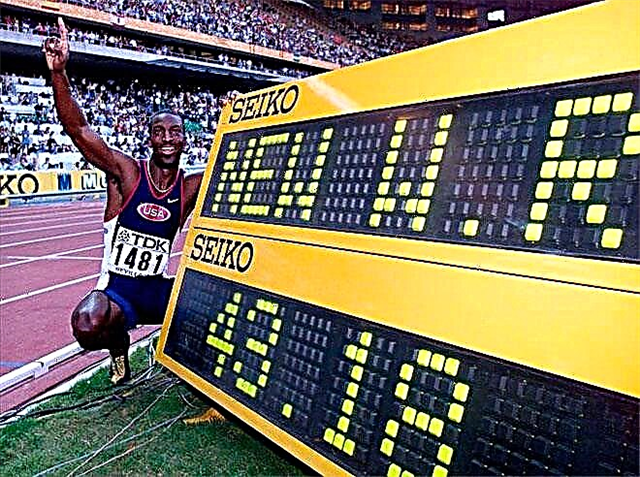Crossfit exercises
8K 2 09/25/2017 (last revision: 12/02/2018)
The barbell row to the chin is an exercise to build strength and mass in the deltoid muscles. It belongs to the isolated category, here we are not very interested in the working weight. It is much more important to do the exercise with a refined technique and achieve good blood circulation in the shoulders. Combined with side dumbbell swings, bench press and back delta bent over extensions, the barbell pull to the chin will give your shoulders the 3-D volume effect that fitness and bodybuilders around the world strive for. The technique of performing the exercise is not devoid of "pitfalls" and requires careful consideration.
Today we will look at how to do this exercise correctly and what mistakes most often occur when performing it.

Types of exercise
In total, there are two types of pull to the chin - narrow and wide grip. There is a fundamental difference between them: the movement takes place in different trajectories, because of this, the emphasis of the load shifts.
Wide grip deadlift
The wide grip variation is a more classic variation. She perfectly works out the middle bundles of the deltoid muscles. Due to the wide setting of the arms, the movement anatomically resembles swinging dumbbells to the sides - at the top point, the elbow is above the hand. Often this exercise is performed in incomplete amplitude, without fully extending the arms at the lowest point. Due to this, the muscles do not have time to relax and "turn off", the feeling of a tearing pump comes much faster.
Close Grip Row
With a narrow grip barbell pull, a slightly different story. Here it is uncomfortable for us to keep our hands parallel to the body and we bring them forward a little. Because of this, the load is more emphasized in the front deltas. Also in the movement, the trapezius muscles take a strong part, with them the athlete holds the bar up to the very end in the upper range of motion.
In both variations, the biceps and forearms are also included. This happens because it is impossible to hold a heavy barbell without straining your arms. Therefore, there is no need to chase weights here, it is much more important for us to feel how the target muscle group is working, and not to indulge our ego. The use of wrist straps is also allowed.
The extensors of the spine and abdominal muscles act as stabilizers in movement. Due to them, we keep the body upright.

Exercise technique
Based on the fact that there are two options for performing the exercise, two techniques should be considered.
Using a wide grip
The technique for performing a wide-grip barbell pull is as follows:
- Pick up the barbell from the floor or racks. Place your arms slightly wider than your shoulders. You should be comfortable with your shoulder joint in a natural position. Keep your back straight, your gaze is directed forward.
- With the effort of the deltoid muscles, we begin to pull the bar up. The movement should be of a pulling nature; there should be no throws or jerks. We raise the barbell smoothly and under control, taking a breath. As the barbell rises, it spreads the elbows slightly to the sides to reduce the middle deltas more.
- Without pausing at the top, return the bar to its original position. In no case should you drop it down, it is dangerous for the shoulder joints. We do not lose the sensation of deltas work even when lowering.
- Without stopping at the bottom point, we do the next repetition.
Using a narrow grip
The technique for performing the barbell pull to the chin with a narrow grip is as follows:
- Pick up the barbell from racks or from the floor. Take it a little narrower than shoulder-width apart, much like a narrow grip bench press. Keep the bar as close to the body as possible so that you are not outweighed forward.
- We begin to do the barbell pull up on the same principle. We try to work only with our shoulders. The closer you hold the barbell to your body, the more your shoulders work. If you extend the bar 5-10 centimeters in front of you, the entire load will go into your hands and trapezoid.
- You will pass the peak point of contraction of the deltoid muscles approximately in the middle of the amplitude. Do not throw the bar up with your hands. It is better to end the movement with the effort of trapeziums, doing something like a barbell shrug. This will work both the shoulders and the trapezius muscles at the same time, killing two birds with one stone.
- As you inhale, lower the bar down and do the next repetition without delay.
Common beginner mistakes
This exercise is quite technically difficult, it is not devoid of some subtleties, without which you will not be able to get the most out of it.


For instance:
- Many people take the name of the exercise too literally. There is no need to reach the barbell to the chin, there is no point in this. This will only load the forearms. To determine the optimal range of motion for yourself, do the following simple trick: while swinging with dumbbells (if, of course, you know how to perform them correctly), pay attention to the level at which the dumbbells are at the top point. Usually somewhere around chest or collarbone level. You should reach the same level with the barbell when pulling to the chin.
- Lack of warm-up. Is it worth reminding that the shoulder joint is the most mobile organism, and injuring it is a piece of cake? Without thorough joint warm-up and warm-up, full-fledged strength work on the shoulders will sooner or later lead to injury. Which is better: spend 10 minutes warming up or then regret your carelessness for several months?
- The weight is too heavy. With a lot of weight, it is almost impossible to feel the contraction and stretching of the deltoid muscles in this exercise. Many experienced athletes do not hesitate to perform this exercise with an empty Olympic bar. But the volume of their shoulders speaks for itself: they are doing everything right.
- This point is closely related to the previous one. Too much strength, the athlete puts the barbell row to the chin at the very beginning of the shoulder workout and works with huge weights. And only after that does he move on to basic presses, when the muscles are already clogged and tired. Remember that this is an isolated exercise and it is much more advisable to do it towards the end of the workout without using a lot of working weight.
- Incorrect boom position. The bar should be kept as close to the body as possible so that it practically slides over the shirt when lifted. The meaning is the same as in the deadlift. Push the bar forward - you will lose control and concentration, there is no benefit from such work.
- Do not twist your hands when holding the barbell. This puts a static load on your forearms. This makes it difficult to concentrate on the work of the deltoid muscles.
- Cheating is inappropriate for this exercise, but only on the last few reps. It makes no sense to do all the repetitions in the swing.









